Trade marketing is a vital yet often overlooked component of a company’s overall marketing strategy. At its core, trade marketing optimizes the relationship between manufacturers and their distribution partners to increase product sales and market share.
This approach bridges the gap between traditional marketing efforts aimed at end consumers and the critical intermediaries who bring products to market.
Definition of Trade Marketing
Trade marketing encompasses manufacturers’ strategies and tactics to promote their products through various distribution channels.
It involves creating mutually beneficial partnerships with wholesalers, distributors, and retailers to ensure products are effectively marketed and sold to end consumers.
Unlike consumer-focused marketing, trade marketing targets the businesses within the supply chain to influence their purchasing decisions and promotional efforts.
Importance of Trade Marketing in the Business World
In today’s complex and competitive marketplace, trade marketing has become increasingly crucial for several reasons:

- Channel Complexity: With the rise of e-commerce and omnichannel retail, managing relationships across diverse distribution channels is more important than ever.
- Retailer Power: Large retailers wield significant influence over product placement and promotion, making strong trade partnerships essential.
- Data-Driven Decisions: Trade marketing leverages point-of-sale data and market insights to inform strategic decisions and optimize product performance.
- Brand Visibility: Effective trade marketing ensures products stand out in crowded retail environments, capturing consumer attention at purchase.
- Revenue Growth: By aligning manufacturer and retailer goals, trade marketing can drive sales volume and increase market share.
Brief History and Evolution of Trade Marketing
Trade marketing emerged in the 1980s as a response to shifting power dynamics in the retail landscape. As large retail chains gained more control over product selection and shelf space, manufacturers recognized the need for a more strategic approach to working with their distribution partners.
Key milestones in the evolution of trade marketing include:
- 1980s: Introduction of trade marketing as a distinct discipline
- 1990s: Growth of category management practices
- 2000s: Increased focus on data analytics and shopper insights
- 2010s: Integration of digital technologies and omnichannel strategies
- Present: Emphasis on personalization and collaborative partnerships
The Role of Trade Marketing in the Marketing Mix
Trade marketing bridges the gap between a company’s overall marketing strategy and sales objectives. It complements traditional consumer marketing efforts by ensuring products are effectively positioned and promoted within distribution channels.
Where Trade Marketing Fits in the Overall Marketing Strategy
Trade marketing typically sits at the intersection of marketing, sales, and supply chain management. It works in tandem with other marketing functions to:
- Align brand messaging across channels
- Develop promotional calendars that coordinate with consumer marketing campaigns
- Create tailored marketing materials for different retail environments
- Optimize product assortments and pricing strategies
- Collaborate on new product launches and innovations
Differences Between Trade Marketing and Consumer Marketing
While both trade and consumer marketing aim to drive sales, they differ in several key aspects:
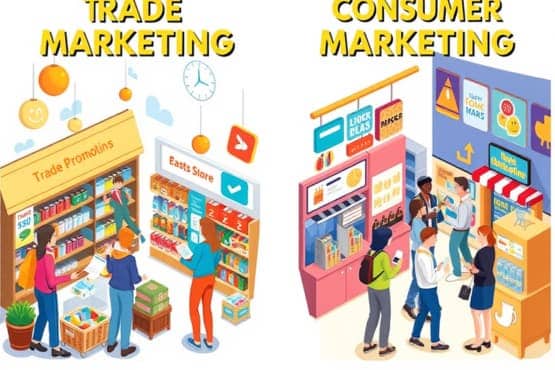
| Aspect | Trade Marketing | Consumer Marketing |
| Target Audience | Wholesalers, distributors, and retailers | End consumers directly |
| Objectives | Secure shelf space, optimize product placement, drive sell-through | Build brand awareness, generate demand, foster customer loyalty |
| Tactics | Trade promotions, co-op advertising, in-store marketing | Mass media advertising, social media, direct-to-consumer campaigns |
| Metrics | Sell-in, sell-through, retail performance metrics | Typically, longer-term brand-building strategies |
| Timeframe | Often shorter-term, tactical timelines | Typically longer-term brand-building strategies |
Key Players in Trade Marketing
Trade marketing involves a complex ecosystem of stakeholders, each playing a crucial role in the journey of products from manufacturer to end consumer.
Understanding these key players and their interactions is essential for developing effective trade marketing strategies.
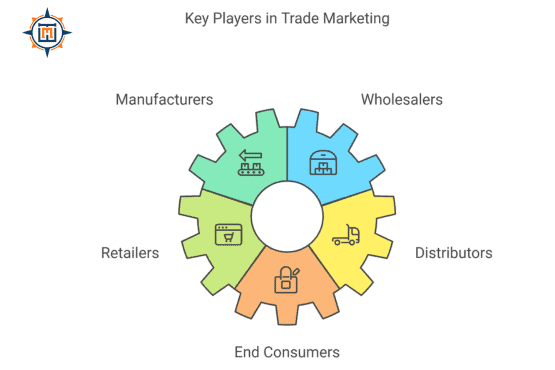
Manufacturers
Manufacturers are the cornerstone of the trade marketing process. They:
- Develop and produce products
- Set initial pricing strategies
- Create brand identities and marketing messages
- Design trade marketing programs to support their distribution partners
Example: A soft drink company like Coca-Cola develops new flavours, sets wholesale prices, and creates marketing campaigns to support its products through various channels.
Wholesalers
Wholesalers act as intermediaries between manufacturers and retailers. Their role includes:
- Purchasing large quantities of products from manufacturers
- Warehousing and inventory management
- Breaking bulk shipments into smaller quantities for retailers
- Providing logistical support and sometimes marketing assistance to retailers
Example: A food wholesaler might purchase pallets of canned goods from multiple manufacturers and then sell mixed cases to individual grocery stores.
Retailers
Retailers are the final link in the distribution chain before products reach consumers. They:
- Select products to stock based on consumer demand and profitability
- Set retail prices and manage in-store promotions
- Create shopping experiences that influence consumer behavior
- Provide valuable point-of-sale data to manufacturers and wholesalers
Example: A department store like Macy’s decides which clothing brands to carry, how to display them, and what promotions to run during different seasons.
Distributors
Distributors often overlap with wholesalers but may provide additional services:
- Represent specific brands or product lines in defined geographic areas
- Offer more specialized knowledge about the products they represent
- Provide marketing and merchandising support to retailers
- May have exclusive rights to distribute certain products in their territory
Example: A beverage distributor might have exclusive rights to distribute certain craft beer brands within a specific state, providing marketing support and managing relationships with local bars and stores.
End Consumers
While not directly involved in trade marketing activities, end consumers are the ultimate target.
Their behaviours and preferences drive decisions all other players in the trade marketing ecosystem make.
Understanding consumer trends and purchasing habits is crucial for effective trade marketing strategies.
Core Objectives of Trade Marketing
Trade marketing aims to achieve several key objectives that benefit both manufacturers and their distribution partners:

Increasing Product Visibility
- Securing prime shelf space and positioning in retail environments
- Implementing eye-catching displays and point-of-purchase materials
- Ensuring consistent stock levels to avoid out-of-stock situations
Strategy Example: Negotiating end-cap displays for a new product launch to maximize visibility in high-traffic areas of stores.
Enhancing Brand Presence at Point of Sale
- Developing branded in-store marketing materials
- Training retail staff on product features and benefits
- Creating immersive brand experiences within retail spaces
Strategy Example: Setting up interactive product demo stations in electronics stores to allow customers to experience the brand firsthand.
Improving Relationships with Trade Partners
- Offering attractive trade promotions and incentives
- Providing marketing and sales support to distribution partners
- Collaborating on data sharing and category management initiatives
Strategy Example: Implementing a co-op advertising program where the manufacturer shares the cost of local advertising with retailers.
Driving Sales and Market Share
- Aligning trade marketing activities with overall sales objectives
- Developing targeted promotions to increase sell-through rates
- Leveraging data analytics to identify growth opportunities within specific channels or regions
Strategy Example: Analyzing point-of-sale data to identify underperforming stores and implementing tailored promotional strategies to boost sales in those locations.
Fundamental Trade Marketing Strategies
Trade marketing employs various strategies to move products through the distribution chain effectively. The three main approaches are push, pull, and hybrid strategies, each with strengths and applications.
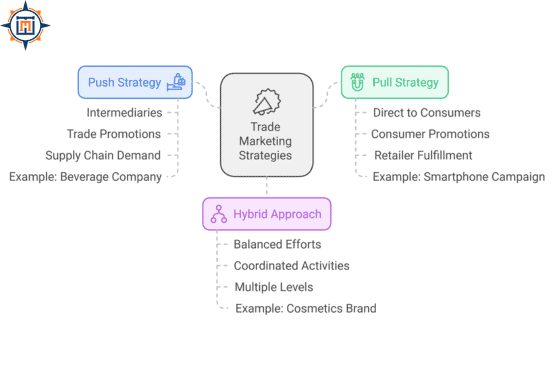
Push Strategy
A push strategy focuses on “pushing” products through the distribution channel to the end consumer.
Key characteristics:
- Emphasizes selling to intermediaries (wholesalers, distributors, retailers)
- Relies heavily on trade promotions and incentives
- Aims to create demand from within the supply chain
Example: A beverage company offering volume discounts to retailers to stock up on their new energy drink flavour.
Pull Strategy
Pull strategies aim to create consumer demand that “pulls” the product through the channel.
Key characteristics:
- Focuses on marketing directly to end consumers
- Utilizes mass media advertising and consumer promotions
- Creates demand that retailers must then fulfill
Example: A smartphone manufacturer running a nationwide TV campaign to generate buzz for their latest model.
Hybrid Approach
Many successful trade marketing campaigns combine elements of both push and pull strategies.
Key characteristics:
- Balances trade and consumer marketing efforts
- Coordinates promotional activities across the entire supply chain
- Maximizes impact by creating demand at multiple levels
Example: A cosmetics brand launching a new lipstick line with in-store beauty advisor training (push) and influencer partnerships (pull).
Essential Components of Trade Marketing
Effective trade marketing relies on several key components working harmoniously to drive product success.
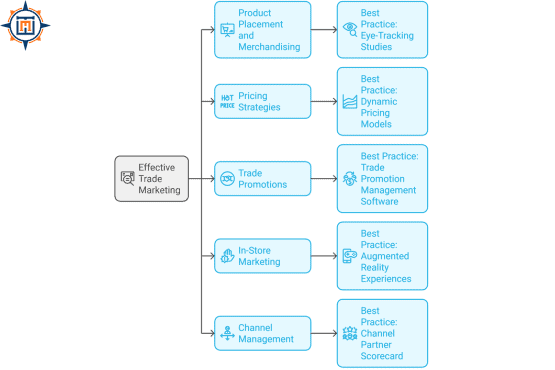
Product Placement and Merchandising
Strategic product placement can significantly impact sales and brand perception.
Key tactics:
- Negotiating prime shelf space
- Implementing planogram strategies
- Creating attractive product displays
Best practice: Use eye-tracking studies to optimize product placement for maximum visibility and appeal.
Pricing Strategies
Pricing is crucial in trade marketing, affecting channel partner relationships and consumer behaviour.
Key considerations:
- Channel pricing and margins
- Promotional pricing strategies
- Price positioning relative to competitors
Best practice: Implement dynamic pricing models based on real-time market data and demand fluctuations.
Trade Promotions
Trade promotions incentivize channel partners to push products more aggressively.
Common types:
- Volume discounts
- Co-op advertising funds
- Performance-based rebates
Best practice: Use trade promotion management software to track ROI and optimize promotional spending.
In-Store Marketing
In-store marketing tactics help products stand out at the point of purchase.
Effective techniques:
- Point-of-purchase displays
- In-store demonstrations
- Branded signage and fixtures
Best practice: Leverage augmented reality technology to create interactive in-store experiences that engage shoppers.
Channel Management
Effective channel management ensures products reach consumers efficiently and profitably.
Key aspects:
- Channel partner selection and evaluation
- Inventory management across channels
- Conflict resolution and relationship building
Best practice: Implement a channel partner scorecard system to objectively evaluate performance and guide resource allocation.
By mastering these fundamental strategies and essential components, trade marketers can create comprehensive campaigns that drive product success across the entire distribution chain.
The Psychology Behind Trade Marketing
Understanding the psychological factors influencing retailer and consumer behaviour is crucial for developing effective trade marketing strategies. Marketers can create compelling campaigns and drive better results by leveraging these insights.

Understanding Retailer Behavior
Retailers make decisions based on a complex set of factors, including:
- Profit Motivation: Retailers prioritize products and brands with the best margins and turnover rates.
- Risk Aversion: Many retailers prefer established brands and products with proven track records.
- Relationship Dynamics: Strong personal relationships with sales representatives can influence buying decisions.
- Category Management: Retailers think of overall category performance rather than individual products.
- Space Constraints: Limited shelf space creates competition among brands for prime positioning.
Best Practice: Develop tailored value propositions for each retailer, addressing their needs and pain points.
Consumer Psychology in Trade Marketing
Trade marketing strategies must also consider the psychological factors that drive consumer behaviour at the point of purchase:

- Decision Fatigue: Consumers face numerous choices, leading to decision paralysis or impulsive purchases.
- Social Proof: Shoppers are influenced by perceived popularity and peer recommendations.
- Scarcity Principle: Limited-time offers or exclusive products can create a sense of urgency.
- Anchoring Effect: Initial price points influence the perception of value and subsequent purchase decisions.
- Sensory Marketing: Visual, auditory, and olfactory cues can significantly impact buying behaviour.
Case Study: A cereal brand increased sales by 18% by redesigning packaging to feature larger, more appealing product images, tapping into the visual appeal aspect of consumer psychology.
Digital Transformation in Trade Marketing
The digital revolution has fundamentally changed the landscape of trade marketing, offering new challenges and opportunities for brands and retailers alike.
E-commerce and its Impact on Trade Marketing
E-commerce has reshaped trade marketing in several ways:
- Shift in Channel Dynamics: Online marketplaces have become influential players in the retail ecosystem.
- Data Availability: E-commerce provides rich data on consumer behaviour and preferences.
- Digital Shelf: Virtual shelf space and search rankings have become as crucial as physical shelf placement.
- Pricing Transparency: Online price comparisons have intensified competition and pricing strategies.
- Direct-to-Consumer (D2C) Models: Brands can now bypass traditional retail channels, changing the power dynamics.
Example: A household appliance manufacturer launched a D2C website, offering exclusive products and personalized bundles, complementing their traditional retail partnerships.
Digital Tools for Trade Marketers
Modern trade marketers leverage a variety of digital tools to enhance their strategies:
- Trade Promotion Management (TPM) Software: Automates and optimizes promotional planning and execution.
- Predictive Analytics: Uses AI and machine learning to forecast demand and optimize inventory levels.
- Virtual and Augmented Reality: Enables virtual product demonstrations and immersive shopping experiences.
- Social Listening Tools: Monitors brand mentions and consumer sentiment across social media platforms.
- E-commerce Analytics Platforms: Provides insights into online sales performance and competitive positioning.
Best Practice: Implement a unified data platform integrating various digital tools, providing a holistic view of trade marketing performance across channels.
Omnichannel Strategies
Successful trade marketing in the digital age requires a seamless omnichannel approach:
- Consistent Brand Experience: Ensure brand messaging and visuals are uniform across all touchpoints.
- Channel Integration: Enable features like buy online pick up in-store (BOPIS) to bridge digital and physical retail.
- Personalization at Scale: Use data to deliver tailored experiences across multiple channels.
- Cross-Channel Attribution: Implement analytics that track customer journeys across various touchpoints.
- Flexible Fulfillment: Optimize the supply chain to support various fulfillment methods (e.g., same-day delivery and in-store pickup).
Case Study: A major beauty retailer implemented an AI-powered personalization engine that delivers customized product recommendations across their website, mobile app, and in-store digital displays, resulting in a 30% increase in cross-channel sales.
By embracing digital transformation and understanding the psychological underpinnings of trade marketing, brands can create more effective, data-driven strategies that resonate with retailers and consumers in today’s complex marketplace.
Data and Analytics in Trade Marketing

Importance of data-driven decision making
Leveraging information for strategic decisions has become crucial in today’s competitive marketplace. Benefits include:
- Enhanced accuracy in forecasting
- Improved resource allocation
- Personalized partner strategies
- Rapid response to market changes
- Increased return on investment
Example: A beverage company increased its promotional effectiveness by 25% after implementing an information-based approach to resource allocation.
Key metrics and KPIs in trade marketing
Essential measurements for success include:
- Sell-through rate
- Return on trade spend
- Share of shelf space
- Out-of-stock frequency
- Partner satisfaction scores
Best Practice: Develop a balanced scorecard combining financial, operational, and relationship-based indicators for a comprehensive performance view.
Using analytics to optimize trade marketing efforts
Advanced analytical tools can enhance various aspects of strategy:
- Promotional planning and forecasting
- Assortment optimization
- Price sensitivity modeling
- Partner segmentation
- Budget allocation optimization
Case Study: A snack food manufacturer used predictive modeling to optimize its product mix, resulting in a 15% increase in category sales at partner retailers.
Trade Marketing Across Different Industries

FMCG (Fast-Moving Consumer Goods)
Characteristics:
- High-volume, low-margin products
- Frequent promotional activities
- Strong emphasis on shelf presence
Key Strategies:
- Innovative in-store displays
- Seasonal promotions
- Collaborative category management
Example: A leading cereal brand partnered with a major grocery chain to create a “breakfast solutions” endcap display, combining cereals, milk, and fresh fruit to drive cross-category sales.
Pharmaceuticals
Characteristics:
- Highly regulated industry
- Complex supply chain
- Long product development cycles
Key Strategies:
- Educational programs for healthcare professionals
- Patient support initiatives
- Compliance-focused promotional tactics
Case Study: A pharmaceutical company developed a digital platform for pharmacists, providing real-time inventory management and educational resources, leading to a 25% increase in prescription fill rates for their products.
Automotive
Characteristics:
- High-value, infrequent purchases
- Extensive dealer networks
- Emphasis on after-sales service
Key Strategies:
- Co-op advertising programs
- Showroom experience optimization
- Integrated digital and physical customer journeys
Innovation Spotlight: An automotive manufacturer implemented virtual reality test drive experiences at dealerships, allowing customers to experience multiple models and configurations without extensive physical inventory.
Technology and Electronics
Characteristics:
- Rapid product cycles
- Tech-savvy consumer base
- Strong online presence
Key Strategies:
- Omnichannel retail experiences
- Product demonstration programs
- Strategic partnerships with complementary brands
Success Story: A smartphone manufacturer partnered with a leading electronics retailer to create store-within-a-store concepts featuring interactive displays and dedicated brand ambassadors, resulting in a 40% increase in market share within those locations.
Challenges in Trade Marketing
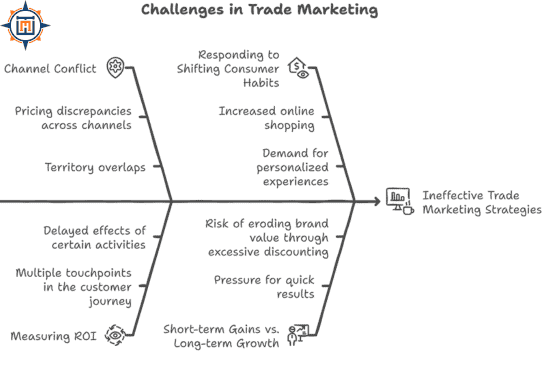
Channel Conflict
Conflicts can arise between different partners in the distribution network, potentially harming overall performance. Common issues include:
- Pricing discrepancies across channels
- Territory overlaps
- Direct-to-consumer initiatives compete with traditional retail
Solution Example: A classic case illustrating channel conflict comes from French hypermarkets like Carrefour. Initially, these retailers grew by using franchise agreements with independent operators. Still, as their franchisees, such as Promodes, grew significantly, they began building their independent supply chains, leading to the termination of original agreements.
This strategic shift highlights the evolving power dynamics in producer-distributor relationships
Measuring ROI
Accurately measuring the impact of various initiatives can be complex due to:
- Multiple touchpoints in the customer journey
- Delayed effects of certain activities
- Difficulty in isolating specific campaign impacts
Best Practice: Implement multi-touch attribution models better to understand each marketing activity’s contribution to overall performance.
Responding to Shifting Consumer Habits
Rapid changes in consumer behaviour require agile strategies:
- Increased online shopping
- Demand for personalized experiences
- Growing focus on sustainability
Adaptation Strategy: A food manufacturer quickly pivoted to emphasize their eco-friendly packaging across all partner channels, resulting in a 20% sales increase among environmentally conscious consumers.
Short-term Gains vs. Long-term Growth
Balancing immediate sales boosts with sustained brand development presents ongoing challenges:
- Pressure for quick results
- Risk of eroding brand value through excessive discounting
- Need for consistent messaging across promotional activities
Case Study: A luxury cosmetics brand limited flash sales to twice yearly, focusing instead on experiential marketing through partner retailers, leading to a 15% increase in full-price sales.
Best Practices in Trade Marketing

Fostering Strong Partner Relationships
Building trust and mutual success with distribution partners is crucial:
- Regular communication and feedback sessions
- Collaborative goal-setting
- Providing value-added services and insights
Success Story: A noteworthy example of effective collaboration is the relationship between large department stores like Debenhams and concessionaires. These stores collaborated with third-party vendors to create ‘shop-in-shop’ models, where vendors operated within department stores.
This arrangement benefited both parties, as it allowed retailers to increase revenue while minimizing risk, and concessionaires gained access to established consumer bases without the overhead costs of running an independent store.”
Maintaining Consistent Brand Communication
Ensuring a unified brand message across all channels enhances brand recognition and trust:
- Develop clear brand guidelines for all partners
- Provide ready-to-use marketing materials
- Conduct regular audits of brand representation
Example: An electronics manufacturer created a digital asset management system for partners, resulting in 95% brand consistency across all retail touchpoints.
Leveraging technology and innovation
Leveraging cutting-edge tools can significantly enhance effectiveness:
- Implementing advanced analytics platforms
- Utilizing augmented reality for product demonstrations
- Employing AI-driven inventory management systems
Innovation Case: A furniture retailer partnered with an AR technology provider to create virtual showrooms, increasing conversion rates by 25% among participating dealers.
Embracing Continuous Improvement
Staying ahead in a dynamic market requires ongoing learning and adaptation:
- Regular market research and trend analysis
- Encouraging innovation and experimentation
- Investing in team training and development
Best Practice: A consumer goods company implemented a quarterly “innovation challenge” for its team, resulting in three successful new product launches within a year.
The Future of Trade Marketing
Emerging Trends
Several key developments are shaping the future landscape:
- Artificial Intelligence for predictive analytics and personalization
- Virtual and Augmented Reality in product showcasing
- Increased focus on sustainable and ethical practices
- Integration of voice commerce and smart home devices
Forward-thinking Example: A home appliance manufacturer is developing AI-powered “smart shelves” that adjust pricing and promotions in real time based on consumer behaviour and inventory levels.

Essential Skills for Future Professionals
To thrive in this evolving field, professionals will need to develop:
- Data analysis and interpretation capabilities
- Digital marketing expertise across multiple platforms
- Agile project management skills
- Understanding of emerging technologies and their applications
- Strong ethical decision-making abilities
Industry Insight: Leading companies are partnering with universities to develop specialized curricula focusing on the intersection of data science, marketing, and supply chain management to prepare the next generation of professionals.
Getting Started in Trade Marketing
Essential skills for trade marketers
Successful professionals in this field should develop:
- Analytical abilities: Interpret complex data and derive actionable insights
- Negotiation expertise: Secure favorable terms with partners
- Strategic thinking: Develop comprehensive plans aligned with business objectives
- Financial acumen: Understand budgeting, forecasting, and ROI calculations
- Cross-functional collaboration: Work effectively across departments
- Technological proficiency: Familiarity with CRM systems and analytics platforms
Career paths in trade marketing
Typical career trajectories include:
- Specialist Route:
- Entry: Junior Analyst
- Mid-level: Category Manager
- Senior: Director of Trade Strategy
- Generalist Path:
- Entry: Sales Representative
- Mid-level: Brand Manager
- Senior: Chief Commercial Officer
- Consulting Track:
- Entry: Associate Consultant
- Mid-level: Senior Consultant
- Senior: Partner, Retail and Consumer Goods Practice
Resources for further learning (certifications, courses, etc.)
To enhance knowledge and skills:
- Professional Certifications:
- Academic Programs:
- MBA with a focus on Retail Management or Supply Chain
- Masters in Marketing Analytics
- Industry Associations:
- Membership in relevant trade organizations
- Participation in industry conferences and workshops
- Online Learning Platforms:
- Courses on retail strategy and marketing
- Programs in supply chain management and analytics
Successful Trade Marketing Examples
Real-world examples of effective trade marketing strategies
- Beverage Company’s Convenience Store Initiative:
- Implemented AI-powered inventory management
- Created custom displays with digital signage
- Developed mobile app for store owners. Results: 35% increase in partner store sales, 50% reduction in stock-outs
- Eco-Friendly Automotive Campaign:
- Launched virtual reality test drives
- Developed interactive environmental impact displays
- Created a gamified staff training program. Results: 60% increase in test drives, 40% improvement in sales conversion
Lessons learned from successful campaigns
- Investing in partner success through technology drives mutual growth
- Immersive experiences can bridge product innovation and customer engagement
- Education and transparency build trust in regulated industries
- Personalization and data-driven approaches yield significant results
- Balancing short-term sales with long-term brand building is crucial
Conclusion
Trade marketing is crucial in today’s dynamic business environment, acting as a key driver of success. It emphasizes data-driven decision-making and industry-specific strategies while fostering strong partnerships and adapting to evolving technology and consumer behaviour.
Balancing short-term objectives with long-term brand development is essential as trade marketing navigates the merging of online and offline channels and meets rising consumer expectations.
Moreover, trade marketing promotes sustainability and ethical values, leading to resilient, customer-centric business models. Ultimately, mastering trade marketing goes beyond just driving sales; it establishes a foundation for companies to thrive in an ever-changing marketplace, ensuring long-term success and growth.
To stay ahead in this evolving field, continuously updating your knowledge and strategies is crucial. For the latest insights and in-depth resources on trade marketing techniques, explore our comprehensive guides at Trade Marketing Insider. Our regularly updated content is designed to help you navigate the complexities of modern trade marketing and drive your business forward.




